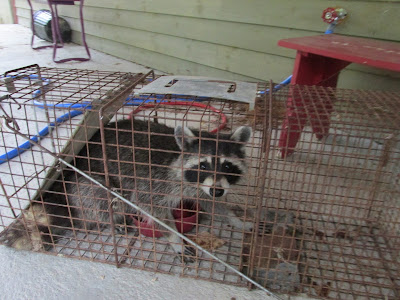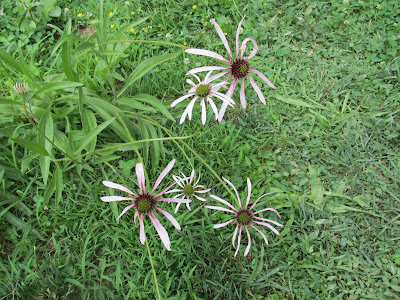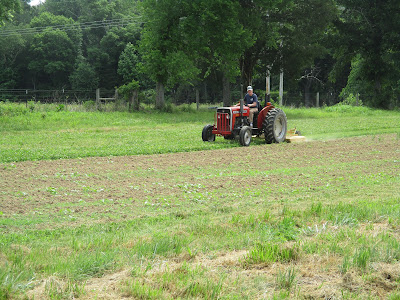14th June, a Sunday, was perfect weather to putter outdoors. I had previously planted a clematis in the new garden, placing the trellis against the west wall. In a few days it became obvious that the heat absorbed in the exposed concrete was too intense for the clematis. Jim moved the trellis around to the wonky wooden fence below the east wall. I replanted the unhappy clematis and put another beside it. Both were sturdy little plants from a reputable mail order nursery; they had been grown on in the shelter of the greenhouse after arriving in early May. I tied the vines to the trellis and placed several flat rocks at the base.
This was the devastation that met my gaze when I went outside early Monday morning.
We decided that the rootling had been done by a raccoon.
A raccoon visited the cat kibble feeder on the lower porch several times during late winter and we hadn't begrudged it the food.
Somewhat reluctantly we decided to bait the Hav-a-Hart trap.
The next morning we had the supposed culprit. Jim was loading the trap into the back of the pickup when I noticed that the raccoon was a female. Immediately we thought of nursing kits left to starve if we trucked their mom away. 'Its your plants, your choice what to do with the coon', said Jim, leaving me to decide. My soft heart caved, hoping the attack on the clematis was a one-time mistake. We released the coon. Pondering the situation later, I recalled that the mother coon's nipples had been shriveled and dry as though her kits were already weaned.
Tuesday morning. Note that these pots were on the front doorstep.
Wednesday morning.
Thursday morning.
Friday morning, on the lower porch.
On Saturday morning this large and belligerent male was in the trap.
Howard hoisted the trap into his truck and we drove down narrow winding back roads to release the coon in an overgrown field.
Subsequently we caught and transported two smaller raccoons.
There has been a heated discussion on the local online 'magazine' re dealing with unwelcome visitations from raccoons.
One writer stated that a friend loaned her a collection of 'rubber snakes' which discouraged nocturnal visits to planters and bird feeders.
Another contributor ranted against the practice of transporting coons to remote areas and rather self-righteously confessed that coons trapped on their property were taken to the farm of a friend who 'uses them to train his dogs.'
Jim doesn't shoot animals, but I contend that a quick bullet would be a more merciful end than being turned loose to be torn apart by hounds in training!
I replanted the clematis vines twice before they were left to grow in peace.
I was able to salvage and re-pot most of the plants thrown about during Mr. Raccoon's nightly rampages. We have since seen a youngish coon mooching about on the front steps but it has caused no upsets.
We've had visiting raccoons in other locations, never any who created havoc.
I've always considered them rather appealing with their pointy masked faces and bushy tails.
Since the destruction ended with the removal of the large male, I hope he was one of a kind.
I started this post using the new blogger format. I loaded 3 photos, couldn't load the remainder so reverted to the older format.



























